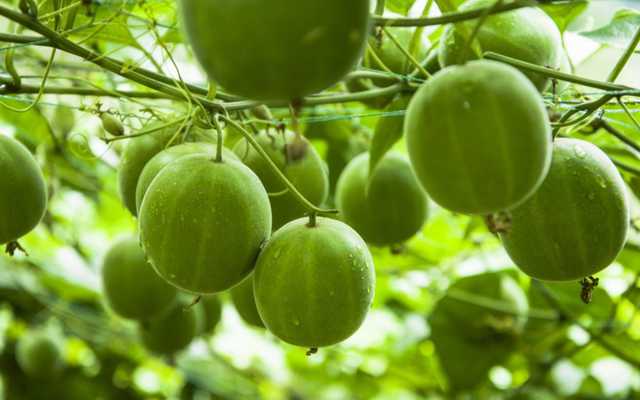Monk fruit is known for its sweetness and is a non-caloric natural sweetener. Now, in a first, scientists of Himalayan Bioresource Technology, Palampur, have introduced the cultivation of monk fruit in Kullu district of Himachal Pradesh.
Monk fruit is known for its sweetness and is a non-caloric natural sweetener, making it ideal for diabetics. Now, in a first, scientists of CSIR’s Institute of Himalayan Bioresource Technology (IHBT), Palampur, have introduced the cultivation of monk fruit in Kullu district of Himachal Pradesh.
IHBT director Sanjay Kumar said monk fruit cultivation was initiated on a trial basis by planting 50 seedlings in farmer Manav Khullar’s fields. If successful, the fruit will be grown commercially.
Monk fruit (Siraitia grosvenorii) is also called luo han guo or swingle. Monk fruit is native to regions of Southeast Asia, including some parts of Thailand and China. Buddhist monks in the 13th century were the first to cultivate the fruit, which is the reason for its name. It looks like a small gourd, and it grows on a vine. Because, fresh monk fruit spoils rather quickly, traditionally, people used dried monk fruit in herbal medicines. Today, monk fruit is most popular as a natural sweetener. The fruit’s extract contains substances called mogrosides, which are intensely sweet.
The sweet taste of monk fruit results primarily from the content of a group of cucurbitane-type triterpene glycosides known as mogrosides. The extracted mixture of mogrosides from monk fruit is about 300 times sweeter than sucrose and hasbeen approved by the U.S. Food and Drug Administration (FDA).
Principal scientist Probir Kumar Pal and his team developed the technology for generating quality planting material, its basic agronomic cultivation practices, fruiting technique and post-harvest management. At present, monk fruit is being cultivated at the Council of Scientific and Industrial Research (CSIR)-run IHBT with good quality fruits under farm conditions. “The plant grows well in mountainous areas with an annual mean temperature of 16 to 20°C and humid conditions,” Kumar said.
Health benefits of monk fruit
The plant is most prized for its sweet fruits, which are used for medicinal purposes and as a sweetener. In traditional Chinese medicine, it is used for cough and sore throat and in southern China it is believed to be a longevity aid. The fruits are generally sold in dried form, and traditionally used in herbal tea or soup.
Safe for diabetes
Monk fruit gets its sweetness from natural compounds called mogrosides. It’s generally safe for those with diabetes because it doesn’t increase blood sugars. Even so, foods and drinks sweetened with monk fruit (as well as some monk fruit sweetener blends) may include added sugars and other ingredients that increase carb and calorie counts or affect insulin sensitivity. Don’t assume all monk fruit products are carb- and sugar-free.
Promotes weight loss
Monk fruit has no calories, carbs, or fat, so it may be a great option for anyone watching their waistline. You can save substantial calories and carbs by simply substituting monk fruit sweetener for table sugar throughout your day. Again, make sure you consume monk fruit products that don’t include added sugars. And save treats made with monk fruit for special occasions because many still include diet-busting ingredients like chocolate or butter.
Anti-inflammatory properties
According to a 2011 study, monk fruit has been used in TCM for centuries to make hot drinks that relieve sore throats and reduce phlegm. The fruit’s mogrosides are said to be anti-inflammatory, and may help prevent cancer and keep blood sugar levels stable.
















